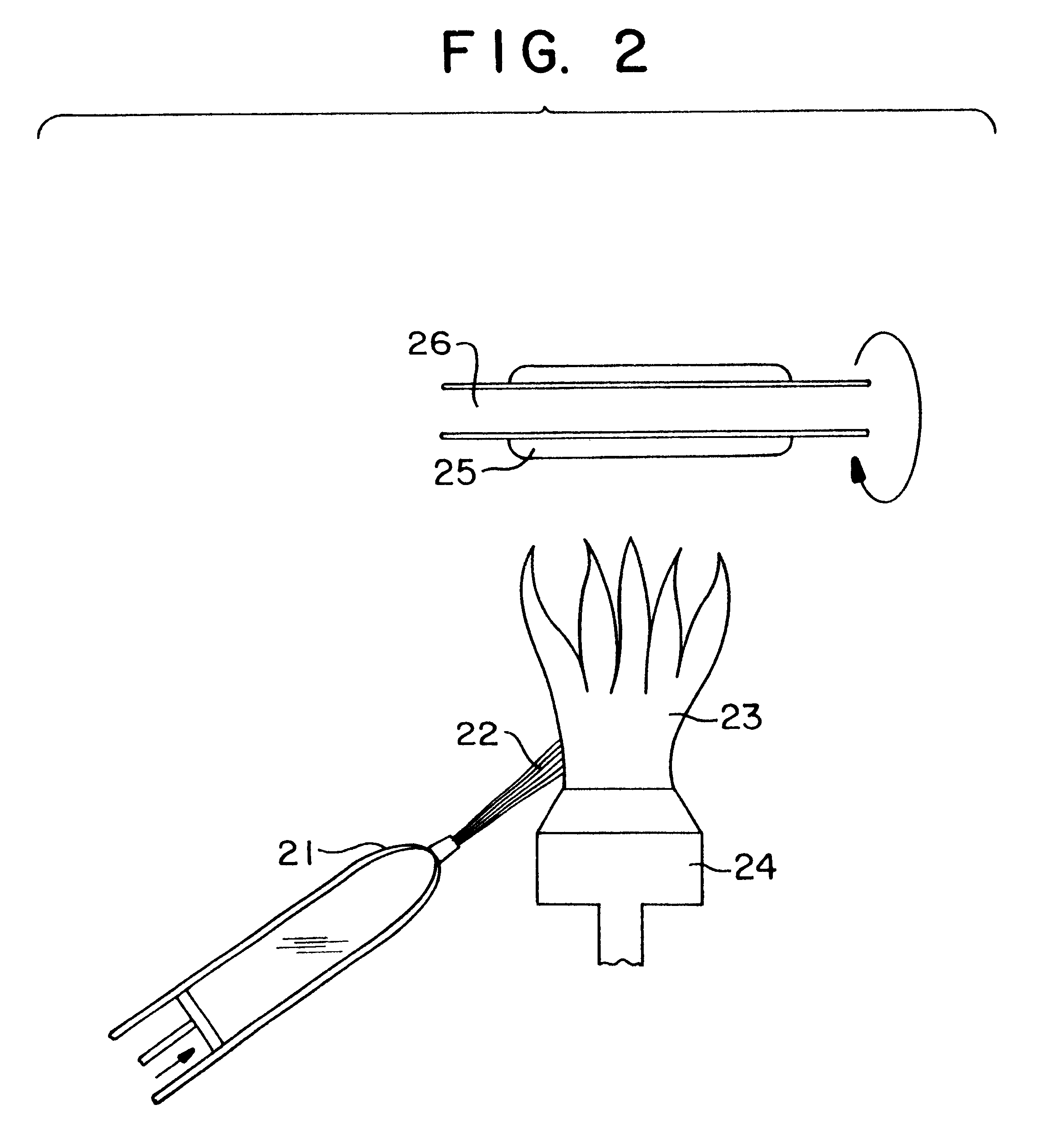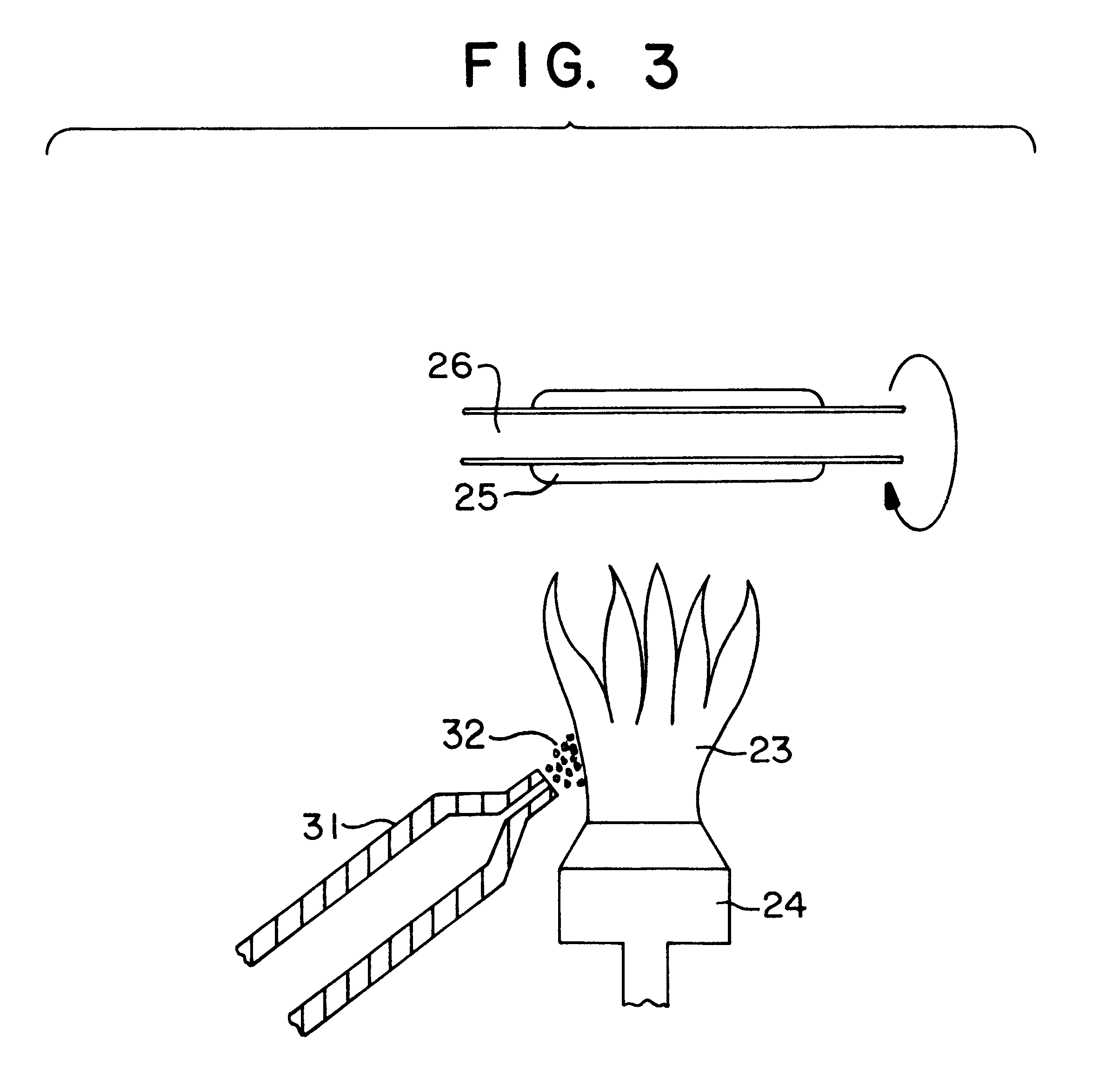Method and apparatus for forming fused silica by combustion of liquid reactants
a technology of liquid reactants and fused silica, which is applied in the direction of manufacturing tools, silicon compounds, glass deposition burners, etc., can solve the problems of affecting the controllability and consistency of the siloxane manufacturing process, and affecting the quality of subsequently drawn optical waveguide fibers, so as to improve the concentricity of the core and cladding regions, prevent burner buildup, and improve the effect of level level
- Summary
- Abstract
- Description
- Claims
- Application Information
AI Technical Summary
Benefits of technology
Problems solved by technology
Method used
Image
Examples
example 2
Generation of Soot Using an Ultrasonic Transducer Atomizer as Injector
Liquid octamethylcyclotetrasiloxane (OMCTS) was delivered to a combustion burner via a Vibra-Cell.RTM. 20-khz ultrasonic transducer atomizer (available from Sonics & Materials, Inc., Danbury, Conn.) inserted down the centerline of the burner. The atomizer was surrounded by two inner rings of oxygen supply and an outer ring of premixed CH.sub.4 / O.sub.2. The following flow rates were employed: octamethylcyclotetrasiloxane (OMCTS), 11 grams per minute; oxygen, 10 standard liters per minute (SLPM); premix, 10 SLPM CH.sub.4 and 8.4 SLPM O.sub.2.
Combustion was continued for about 10 minutes. A good deposit of SiO.sub.2 soot was collected on the mandrel, further demonstrating the practicality of producing SiO.sub.2 from a siloxane feedstock introduced as small liquid particles into the burner flame.
example 3
Soot Generation by an Atomizing Combustion Burner
An atomizing burner was constructed as depicted in FIG. 4. Various dimensions of atomizer 41 and the surrounding channels were tested, as follows:
inner diameter of atomizer 41: 0.007 to 0.015 inch
inner diameter of channel 43: 0.036 to 0.050 inch
outer diameter of channel 43: 0.048 to 0.063 inch
Using an atomizer 41 having an 0.015-inch inner diameter, particles of soot were generated from octamethylcyclotetrasiloxane (OMCTS) for 65 minutes. Flow rates were as follows:
Premix through channel 46: 10 SLPM CH.sub.4 and 8 SLPM O.sub.2.
O.sub.2 through channels 44 and 45: 26 SLPM.
N.sub.2 through channel 43: 5.6 SLPM.
Octamethylcyclotetrasiloxane (OMCTS) through atomizer 41: 6 milliliters per minute (ml / min) for first five minutes, then 10 ml / min for next 60 minutes.
The target or bait, a 1-inch diameter glass rod, was set to rotate between 1 and 5 rotations per second, traversing back and forth at about 15 meters per minute. The burner to bait re...
PUM
| Property | Measurement | Unit |
|---|---|---|
| Velocity | aaaaa | aaaaa |
| Velocity | aaaaa | aaaaa |
| Kinetic energy | aaaaa | aaaaa |
Abstract
Description
Claims
Application Information
 Login to View More
Login to View More - R&D
- Intellectual Property
- Life Sciences
- Materials
- Tech Scout
- Unparalleled Data Quality
- Higher Quality Content
- 60% Fewer Hallucinations
Browse by: Latest US Patents, China's latest patents, Technical Efficacy Thesaurus, Application Domain, Technology Topic, Popular Technical Reports.
© 2025 PatSnap. All rights reserved.Legal|Privacy policy|Modern Slavery Act Transparency Statement|Sitemap|About US| Contact US: help@patsnap.com



